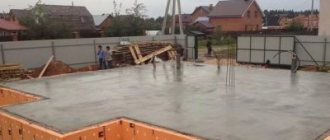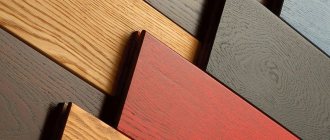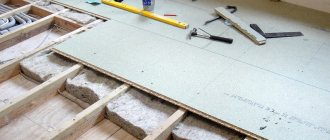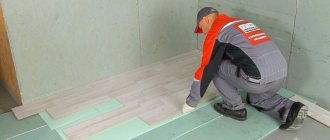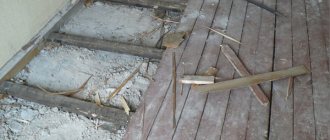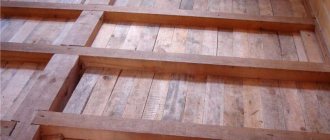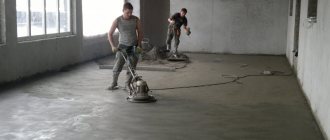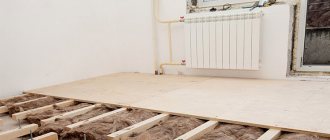Floor insulation is necessary to reduce heat loss both after laying a heated floor system and during installation of the finishing coating. Now there are many types of this useful material on the market, but foil floor insulation is recognized as the leader among them. How to choose the right foil insulation? What are the nuances during installation? We will answer these questions in our article.
Foil insulation for floors
Foil insulation
Foil insulation for floors
The variety of products in construction stores is very large and it is extremely difficult not to get confused among the entire assortment and choose a truly high-quality, effective material, the use of which will not force you to soon redo all the repairs, but, on the contrary, will give you the joy of the fact that it was carried out using high-quality materials .
What is reflective insulation
Foil insulation is a relatively new material on the market. Previously, the category of insulation for floors, walls, and roofs was represented by one single type - mineral wool, which had a lot of disadvantages. This material gets wet, and when in contact with water it loses most of its properties. At the same time, working with it was difficult due to unpleasant tactile sensations, and sometimes dangerous.
Mineral wool
Foil insulation is a two-layer material, most often supplied in rolls, but is sometimes also found in the form of slabs. Layers are represented:
- directly with insulating material, such as polystyrene foam, polystyrene foam, penofol, etc.;
- foil on a layer of insulation, which has certain heat-reflecting qualities.
On a note! Foil insulation has special properties precisely due to the presence of a foil layer. It has the ability to reflect thermal energy and direct it inside the room, preventing it from escaping outside, strictly limiting the area of heat distribution.
Foil floor insulation consists of two layers
Also, material covered with foil does not get wet, which means it also has certain water-repellent properties, although it cannot be used as a waterproofing coating.
Depending on the type of material from which this type of insulation is made, it can be thick or thin, retain heat worse or better, have pores of different sizes, which contain air in one quantity or another.
Polyethylene foam
Application of penofol
Even for household needs, this universal material is used quite widely. Let's consider the main directions.
Insulation of wooden floors
Most often, floors in a wooden house are insulated with penofol. This process is absolutely simple, you can easily do it yourself, just follow this technology:
- It is best to remove the old boards and lay several layers of penofol between the joists. In this case, all layers of material must be laid with a foil base inside the room. Then old boards are laid in place or a sheet of plywood is stuffed.
- Another way is to lay the heat insulator on top of a wooden covering. One layer of insulation is used, and the installation is done end-to-end, and the seams must be taped with aluminum tape. Then sheets of plywood are laid on the laid thermal insulation layer and screwed to the wooden base with self-tapping screws.
Advice! It is impossible to attach penofol to a wooden base mechanically, for example, with staples. If there is a need to fix the insulation, it is better to treat it with glue or use an adhesive-based material.
Thermal insulation of concrete floors
As a rule, penofol is used in combination with other types of thermal insulation materials for insulating concrete floors in a house or on a balcony. The technology of work is as follows:
- First of all, the concrete base must be thoroughly cleaned and leveled. In some cases, a self-leveling screed or self-leveling mixture is used for this.
- Then penofol is laid on the base. To do this, it is better to use a material with a double-sided foil layer. All joints must be made end-to-end and sealed with aluminum tape.
- After this, a wooden frame is installed from bars with a minimum cross-section of 5×5 cm.
- The next step is to fill the space of the wooden frame with any insulation: pressed mineral wool, polystyrene foam or others.
- Now you need to lay another layer of penofol. For this, a one-sided foil base is suitable, which must be directed into the room.
- The insulation of the concrete base is completed by installing plywood or boards over wooden joists.
Properties of foil thermal insulator
Good insulation with a layer of foil has not only heat-insulating properties. It is distinguished by high levels of sound insulation, is not afraid of temperature changes, protects the room from moisture penetration, and has vapor barrier properties.
Expert opinion
Afanasyev E.V.
Chief editor of the pol-exp.com project Engineer.
A heat insulator with a foil layer is in most cases an environmentally friendly material; it does not harm human health or the environment. It can be safely used in children's rooms, as it is non-toxic.
Penofol
Foil insulation, especially from the category of materials made from penofol or expanded polystyrene, is resistant to mechanical stress - even heavy furniture can be placed on the floor under which such material is laid. The insulation will not lose its properties even in this case.
It is especially important to use foil insulation when installing heated floors. It will minimize heat loss, making the room warmer, and the cost of paying utility bills will be significantly reduced. The working insulating layer itself prevents cold air from outside from penetrating into the apartment, and the foil will ensure that heat is retained inside it.
Installation of penofol inside the house
At the same time, installation of foil insulation is very simple and it does not matter whether it is supplied in rolls or slabs. The material is easy to process - in order to cut a piece of a suitable size, you do not need to purchase any complex equipment. It is enough to have any cutting tool with you.
Attention! If no insulation was used during the installation of the floor covering or heated floor system, this is considered a gross mistake and a violation of the material laying technology.
What does a pie look like for a heated floor?
Stability of characteristics
Groups of porous materials, such as polyethylene foam and expanded polystyrene, have an unpleasant feature. Over time, under the influence of static stress (burden from lying pipes and the load when walking on the floor) they are compressed. The thickness of the substrate decreases, the process may proceed unevenly, differing in different areas of the room. This can cause unpleasant consequences.
You need to select a substrate material based on the service life and physical characteristics declared by the manufacturer. Temporary changes in geometry are taken into account, as well as production technology. For example, expanded polystyrene foam has an open structure and sticks together over time. At the same time, extruded has completely closed cells, is elastic, retains its geometry and properties for decades.
Advantages and disadvantages
The main advantage of any insulation with a foil layer is its technical performance, which is significantly increased compared to similar materials, but without a foil layer. However, due to additional production costs and complicated technology, such a heat insulator is more expensive. In general, foil insulation has a lot of positive qualities.
Insulation with foil is significantly superior to conventional heat insulators
Advantages of the material:
- sound insulation;
- safety from an ecological point of view in most species;
- resistance to temperature changes;
- moisture resistance;
- easy installation;
- high thermal insulation properties;
- durability.
Pros and cons of foil insulation
The disadvantages of the material include softness, which prevents the use of foil insulation when laying some soft types of floor coverings, as well as high cost compared to ordinary thermal insulation materials.
How and where to use insulation with foil
Foil insulation can be used on almost all surfaces of the room, depending on its purpose. They are used for laying walls, roofs, ceilings and floors.
Izover
On a note! Foil insulation for floors is indispensable in rooms located on the first floors.
Where can foil insulation be used:
- when installing a heated floor system;
- to protect floors from penetration of cold from the basement;
- to ensure thermal insulation of walls;
- when installing a roof in a private house;
- when insulating balconies, loggias, verandas;
- when laying water supply and drainage pipes;
- in baths and saunas in order to preserve thermal energy indoors.
Using foil insulation in a bathhouse
In general, the type and method of using foil insulation depends on the room in which the repair work is being carried out, as well as on the purpose of this room, the properties and microclimate of the building, etc.
Specifics of Izolon
Izolon is produced by foaming polyethylene with small cells and closed pores.
Izolon based on fine-cell polyethylene foam has high thermal insulation properties and low weight. Some modifications are made with single- or double-sided lamination with aluminum foil. The thickness of the coating is 14 microns and provides waterproofness as well as reflective properties.
The material also has a reinforced frame in the form of a propylene mesh. The basis of Isolon is self-adhesive or glueless. There are combined varieties with foil and adhesive base on sale. To prevent the sheets from sticking together during transportation, a protective film is applied to the adhesive surface.
Types of foil insulation
| Photo | Name | Rating | Price | |
| #1 | Expanded polystyrene | ⭐ 96 / 100 | More details | |
| #2 | Polyethylene foam | ⭐ 98 / 100 | More details | |
| #3 | Mineral wool | ⭐ 81 / 100 | More details | |
| #4 | Basalt insulation | ⭐ 87 / 100 | More details |
In general terms, it is clear what properties a heat insulator with foil has, however, depending on the type of material, they may differ slightly.
Expanded polystyrene
It is a rather voluminous and thick sheet of material with a layer of foil on one of the surfaces. It is produced using complex technology, during which individual polystyrene granules are fused into a single whole. As a rule, it is installed where there is high humidity and significant mechanical impacts on the floor covering are possible. Most often - when installing a water heating system.
pros
- durable material that is not subject to rotting;
- not afraid of fungus and mold;
- does not lose its qualities during sudden temperature changes ranging from -180 to +180 degrees.
Minuses
- This material is used only for installing a thermal insulation layer on the floor.
Foiled polystyrene foam
Polyethylene foam
Rolled material with a thin aluminum coating on one or both sides. The thickness of the heat insulator varies from 2 to 10 mm. It is usually used to insulate floors and walls, sewers or ventilation shafts. Interestingly, foamed polyethylene is also used in the shoe industry - insoles are made from it.
pros
- easy to install;
- has low weight;
- often equipped with an adhesive layer on one side, which simplifies its attachment to surfaces.
Minuses
not detected.
Foamed polyethylene foil
Specifications:
- specific gravity of a coating with a thickness of 5 mm – 60 kg/m;
- thermal conductivity – 0.038 W/(mK).
Foiled polyethylene foam includes penofol, ecofol, isolon and other materials.
Most often, penofol (ethylene foam) is used for installing floors. This material, depending on its qualities and characteristics, can be divided into 4 types:
- A – covered with foil on only one side, a classic and familiar material. Rarely used in rooms with high air humidity, but can be installed in such rooms when laying a layer of waterproofing;
- B – has a foil coating on both sides, a very dense type of heat insulator. No additional installation of a moisture-protecting layer is required;
- C – material that has a foil layer on one side and a self-adhesive layer on the other;
- ALP is a heat insulator with one layer of foil, but laminated with polyethylene. Used when installing an electric floor heating system;
- R – one side is embossed, the other is smooth;
- Super NET - among all types, has the maximum thermal insulation performance, can be used for many years and not lose its properties.
Penofol can be of several types
On a note! A good insulation material is polypropylene film, which has metal inclusions, due to which heat is evenly distributed over the entire surface of the floor and is retained for a long time.
The material is self-adhesive. Peel off the film
Polyethylene foam foil
Mineral wool
A type of insulation familiar to many. Mineral wool with foil is sold in the form of rolls or slabs and is usually used for thermal insulation of roofs, floors in bathhouses and on loggias or balconies. The foil layer is applied only to one side of the material. The thickness of mineral wool can vary from 5 to 10 cm. The base is a basalt slab or fiberglass. When installing even in non-residential premises or outside the house, it is recommended to cover it with film.
pros
- low cost.
Minuses
The material is far from safe for health, and it is not worth using such insulation in an apartment. It can cause the development of respiratory tract diseases, as it releases a dangerous substance – phenol – into the air.
Mineral wool foil
Basalt insulation
This type of insulation belongs to the category of materials based on mineral wool. It is used in the construction of stoves and fireplaces due to its non-flammability. Used for thermal insulation of walls and roofs, floors between floors.
pros
- not afraid of exposure to external environmental factors;
- not flammable;
- ease of installation.
Minuses
- increased thermal conductivity when wet.
Foil basalt insulation
Briefly about the main thing
Isolon is a universal insulation material that is widely used not only in construction, but also in other areas of the economy. Thanks to its closed porous structure, it has improved performance characteristics: plasticity, minimal water absorption, high levels of noise and heat protection.
The chemically neutral material is produced in the form of canvas (roll), plates and construction tape; There are colored varieties for creative needs. The canvas may have an adhesive and/or foil layer. The choice of the appropriate PPE option depends on the type of work to be done.
Ratings 0
Nuances of fastening and installation
When laying foil insulation, you may need the following tools and materials:
- nails with large heads;
- stapler;
- hammer;
- construction tape.
When installing insulation with foil, it is important to avoid the mistake of laying the material with the shiny side down. In this case, the material will not perform its heat-reflecting functions. The foil side must “look” into the room in order to be able to return thermal energy to the room.
An example of laying lag on foil insulation
Advice! You can leave a small air gap between the insulation and the floor covering. Then the floors will be even warmer.
It is also important to remember that the insulation does not overlap. The sheets should be placed end to end and secured with tape or nails, depending on the type of base. Insulation with an adhesive layer may not be additionally fixed, but it is still recommended to secure it with fastening materials. All joints after laying the material are taped.
Thermal insulation for heated floors
Work on laying insulation can be dry or wet. In the second case, the material will be filled with concrete screed. In the first one, it is advisable to install an additional waterproofing layer.
conclusions
- Installation of warm water floors must begin with an assessment of the situation and measurements. It is necessary to decide whether the heated floor will be the main or additional type of heating of the room.
- The choice of the best underfloor heating must be approached responsibly and based on the characteristics of the room, taking into account not only the area of the room and the expected temperature, but also the humidity and height of the ceilings.
- It is much safer to use those materials that are specifically designed for warm water floors. This approach will not only save time, but will increase service life and save up to 20% on energy spent on heating the room.
It is better to purchase a substrate for a warm water floor in specialized stores, which will protect you from purchasing low-quality products.
Roll material laying technology
Step 1. The material produced in a roll must be laid on a surface cleared of debris. The base is swept, washed if necessary and dried.
Preparing the base
Step 2. The insulation is cut into pieces of the required length and size.
Cutting foil insulation
Step 3. The material is leveled over the surface of the room.
The insulation is leveled over the surface
Another photo of the process
Step 4. In small rooms, the insulation is attached along the walls and across with wooden blocks. Its individual sheets are glued together with tape.
The insulation is attached using bars
The process of installing bars
Step 5. If the floor covering allows it (it is quite dense), then lathing is done on top of the laid insulation. This makes it possible to create an air gap.
Creating a sheathing
Next, the floor is covered with a finishing coating or filled with concrete screed; work is also carried out on the installation of heated floors, if necessary.
Warm floors are a serious cost item during renovation, so it is important to accurately calculate how much and what materials will be needed. To ease your labor costs, we have prepared special instructions telling you how to calculate a heated floor - water or electric. Online calculators included. And in the article “ What do you need for a heated floor? » you will find a complete list of everything that may be needed during installation.
Video - Laying roll backing
Insulation with a layer of foil is a good option for high-quality thermal insulation material. It will serve for many years if you choose it correctly in accordance with operating conditions, as well as with proper installation. It’s easy to avoid mistakes; the main thing is to carefully familiarize yourself with all the nuances of using the material.
* * * * * * *
For purely practical reasons, and also as an example of the effectiveness of using foil insulation, especially when combined with other thermal insulation material, below is a calculator for calculating the insulation of a balcony. Since it makes no sense to consider the floor on a balcony or loggia separately, the calculator allows you to make calculations for the entire room, for each of the surfaces that require thermal insulation.
Brief explanations on how to use the program will be given below.
